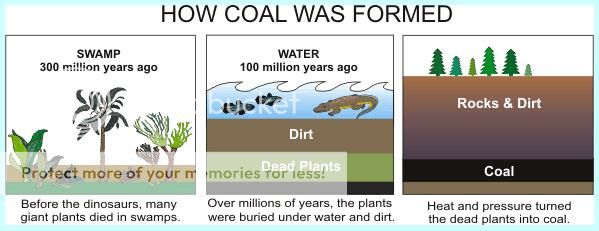This EarthCache is about the story that coal tells.
So what is coal?
Coal is a fossil fuel. It is derived from plant material that was buried millions of years ago in a four step process:
1. Lush vegetation grew in warm swampy areas that covered much of the United States (and the world) about 300 million years ago. The plants and trees absorbed the rays of the sun - used in photosynthesis - which was stored in the leaves and tissues.
2. As the vegetation died, it fell into the swamps. As the amount of material accumulated in the presence of the water, it began to form a spongy, brown material which we know as peat or peat moss.
3.Over time, geologic forces buried the peat bogs - sometimes hundreds of feet deep - where they were compacted by the pressure of the soil and rock on top of them.
4. Coal was gradually formed from the buried peat. The greater the pressure under which the coal was formed, the harder the coal that was produced.
Coal is fossilized dead plant material that once piled deep on the bottom of ancient swamps. Coal differs from every other kind of rock in that it is made of organic carbon: the actual remains, not just mineralized fossils, of dead plants. Today the vast majority of dead plant matter is consumed by fire and decay, returning its carbon to the atmosphere as the gas carbon dioxide—it is oxidized. The carbon in coal, however, was preserved from oxidation and remains in a chemically reduced form, available for oxidation.
Peat is a deposit of woody dead plant material, the precursor to coal and petroleum. Peat is plant matter that is partially decomposed under conditions of no oxygen. When dug from the ground peat is about 75 percent water by weight; once dried it is about 60 percent carbon and makes a useful fuel in many regions. Peat forms large and widespread deposits in the northern latitudes, where wet ground (peat bogs and fens) and abundant plant growth favor its preservation. Peat turns slowly into coal with burial and pressure as gentle heat drives out light hydrocarbons. These volatile compounds become petroleum
Coal geologists study coal just the way other geologists study other rocks. But instead of talking about the minerals that make up the rock (because there are none, just bits of organic matter), coal geologists refer to the macerals, of which there are three groups: inertinite, liptinite, and vitrinite. To oversimplify a complex subject, inertinite is generally derived from plant tissues, liptinite from pollen and resins, and vitrinite from humus or broken-down plant matter.
 There are four major types of coal.
There are four major types of coal.
From the softest to the hardest they are:
Lignite coal - The softest of the four types of coal. It is a brownish black in color, very crumbly and primarily used for the generation of electricity. Because of its color, it is often referred to as "brown coal." Lignite is the result of millions of tons of plants and trees that decayed in a swampy atmosphere about 50-70 million years ago. The material on top of the lignite deposits in North Dakota and Montana - called overburden - was deposited by runoff from the west as the Rocky Mountains formed. The carbon content of lignite is 25%-35% and it has a very high water content - about 35 percent.
Sub-bituminous coal - This is a medium soft coal that contains much less moisture than lignite and is not nearly as crumbly. Like lignite, its primary use is in the generation of electricity. The carbon content of sub-bituminous coal runs from 35%-45% and its heat value generally ranges from 8,000-13,000 Btu's per pound. It is produced primarily along the east side of the Rocky Mountains from eastern Montana to the four corners area where the states of Arizona, Colorado, New Mexico and Utah join.
Bituminous coal - contains even less moisture than the sub-bituminous type. The carbon content of bituminous coal is generally from 45%-85%. In addition to being used for electrical generation, it is also used in making coke or coking coal, an essential ingredient in making steel. Most production of bituminous coal is from the east coast to the midwest states and in Alaska.
Anthracite coal - is the hardest of the four types. It averages 85%-95% carbon content and has the highest heating value of the four types of coal. Anthracite is mined in only a few areas, mostly in the eastern Pennsylvania region. It is used extensively in municipal water purification and treatment plants and for home heating.
So, now it is time to apply what you have learned about coal.
At the waypoint 1, you'll find an example of coal-
1. Based on what you see, of the four types of coal listed above, which type is this?
What are you basing this on? (how does the coal feel, what colour is it, etc)
2. Based upon the presence of coal in this area, what can you say that this area was like about 300 million years ago?
I would like to thank John Pasa: Operations Manager, Rathbun Project Office, for granting me permission to develop this EarthCache at this special place.
